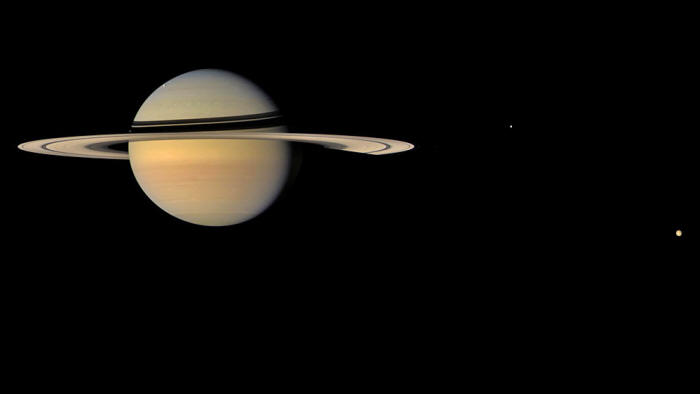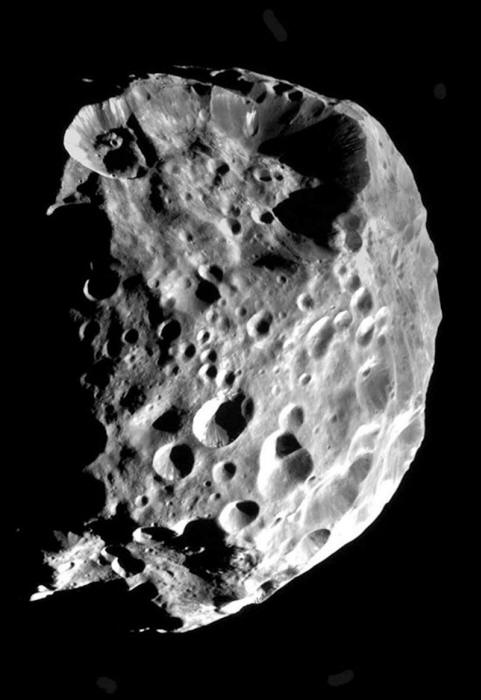|
December 06, 2018 appear in this image snapped by Cassini in 2007. The entire system, save one moon, appears to have water similar to that of Earth, which is unexpected based on
our
current models of how the solar system formed.
Two unexpected results from Cassini could change our picture
of the solar
system...
But every so often, something throws a wrench in our theories, and that may have just happened.
Researchers have discovered interesting new properties of Saturn and its moons that contradict our current models for how the solar system formed.
In a paper accepted November 28 to the journal Icarus, researchers from,
...report their measurements of isotope ratios in the Saturn system.
Studying the abundance of certain isotopes helps astronomers piece together an object's history.
These researchers found that, based on spectroscopic observations of the Saturn system from Cassini, the water in Saturn's rings and moons is surprisingly like the water on Earth - an unexpected result, given their disparate locations.
Even stranger, the water on Saturn's moon Phoebe (and only Phoebe) is unlike the rest of the water in the Saturn system, suggesting it formed even farther out in the solar nebula, rather than in place around the ringed planet.
Earthlike water
To make these discoveries, the team developed a new way to measure isotope abundances in the readings taken by Cassini's Visual and Infrared Mapping Spectrometer (VIMS).
In particular, they studied the ratio of deuterium to hydrogen (D/H) in the water in the Saturn system.
Deuterium is an
isotope of hydrogen with one proton and one neutron in its nucleus;
D2O, which is water that contains deuterium instead of hydrogen, is
commonly known as heavy water because of the added mass from the
extra neutrons.
Based on comparison of laboratory spectra with the VIMS results, the team discovered the bulk of the Saturn system's water, including the water in the planet's rings and on its moons (except Phoebe),
However, our current models for the formation of the solar system state that the D/H ratio farther out in the solar system should be higher than closer in.
If Earth formed close to the Sun and Saturn far from it, why is their water so similar?
One oddball
Saturn's moon Phoebe seems to be the system's oddball; it likely didn't form in place, but was captured after forming
much farther out in the solar system.
On Phoebe, the D/H ratio,
In other words,
The only other way for Phoebe to have such a high D/H ratio, the paper says, is for processes to have enhanced its present-day deuterium supply over time.
These processes, however,
Too much deuterium isn't the only thing that makes Phoebe odd.
In addition to measuring the D/H ratio, the researchers were also able to measure a different isotopic ratio - that of carbon-13 (13C) to carbon-12 (12C) - in the carbon dioxide on both Phoebe and Iapetus (the only two worlds with enough carbon dioxide to make the measurement).
While Iapetus' 13C/12C ratio closely matches Earth's, Phoebe's ratio is also skewed, showing five times more 13C than the "normal" 12C.
This oddity, too, points toward an origin for the small moon farther out in the solar system, with different processes responsible for the carbon dioxide on the two moons.
Also of note is the fact that, although dust from Phoebe is known to coat the leading side of Iapetus,
So, what do astronomers do with this unexpected information?
In addition to potentially updating solar system formation models to more accurately represent reality, getting measurements of the isotope ratios farther out in the solar system can bolster the case for Phoebe's far-out formation, as well as paint a clearer picture of the distribution of hydrogen, carbon, and other elements (and their isotopes) throughout our early solar nebula.
Fortunately, with our army of current and upcoming space telescopes and remote missions - including Europa Clipper, on which Clark is a co-investigator - those measurements may soon become a reality...
|



